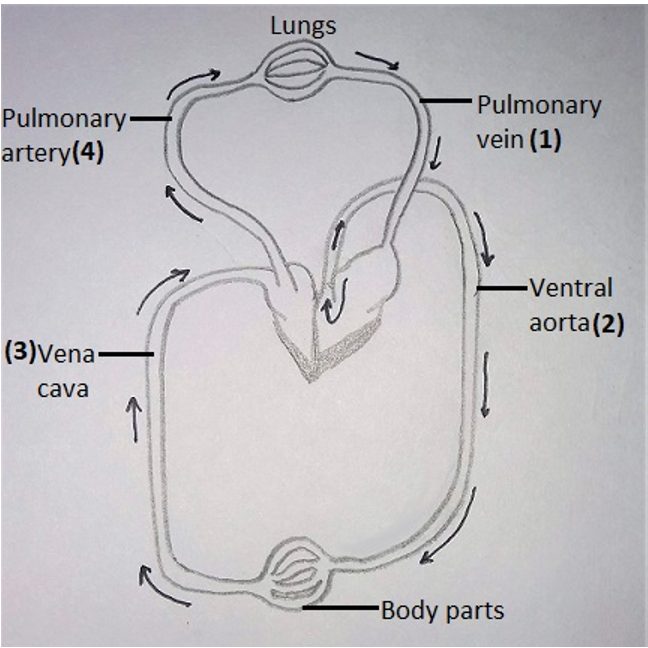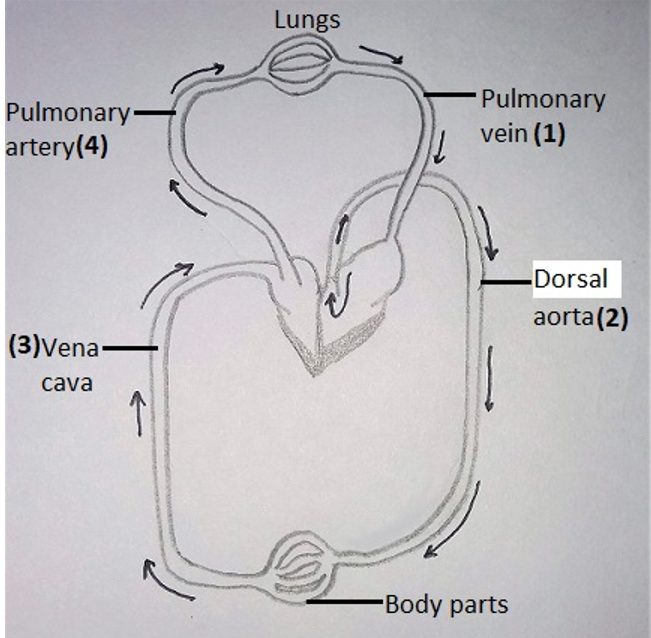This set of Class 11 Biology Chapter 18 Multiple Choice Questions & Answers (MCQs) focuses on “Double Circulation”.
1. How many types of circulatory pathways are present in the animal kingdom?
a) One
b) Two
c) Three
d) Four
View Answer
Explanation: The circulatory pathways are of two major types-open circulatory systems and closed circulatory system. The closed circulatory system is considered to be more advantageous as the flow can be more precisely regulated.
2. How many chambers are present in the heart of crocodiles?
a) Two
b) Three
c) Four
d) Five
View Answer
Explanation: All vertebrates possess a muscular chambered heart. Amphibians and the reptiles (except crocodiles) have a three-chambered heart while crocodiles, birds and mammals possess a four-chambered heart.
3. Which of the following organisms show single circulation?
a) Fishes
b) Birds
c) Mammals
d) Reptiles
View Answer
Explanation: In fishes, the heart pumps out deoxygenated blood which is oxygenated by the gills and is supplied to the body parts where deoxygenated blood is returned to the heart. This type of circulation is known as single circulation.
4. Which of the following organisms show incomplete double circulation?
a) Birds
b) Reptiles
c) Mammals
d) Crocodiles
View Answer
Explanation: In amphibians and reptiles, the left atrium receives oxygenated blood from the gills/lungs/skin and the right atrium gets deoxygenated blood from other body parts. However, they get mixed up in the single ventricle which pumps out mixed blood and is therefore known as incomplete double circulation.
5. Which of the following organisms do not show double circulation?
a) Birds
b) Mammals
c) Crocodiles
d) Reptiles
View Answer
Explanation: In crocodiles, birds and mammals, oxygenated and deoxygenated blood is received by the left and right atrium respectively. The ventricles pump it out without any mixing up, i.e., two separate circulatory pathways, hence these animals have double circulation.
6. The heart is an ectodermally derived organ.
a) True
b) False
View Answer
Explanation: Heart is derived from the innermost germ layer i.e., mesoderm. It is situated in the thoracic cavity, in between the two lungs and is slightly tilted to the left. Skin, nails, lens of the eye, the mouth are all derived from ectoderm.
7. Which of the following is not included in the human circulatory system?
a) Heart
b) Blood vessels
c) Blood
d) Skin
View Answer
Explanation: Human circulatory system which is also called a blood vascular system consists of a muscular chambered heart, a network of closed branching blood vessels and blood, the fluid which is circulated.
8. The heart is covered by a membranous bag of how many walls?
a) One
b) Two
c) Three
d) It is not covered by a membranous bag
View Answer
Explanation: Heart is protected by a double-walled membranous bag, pericardium, enclosing the pericardial fluid which acts as a shock absorber. Our heart consists of four chambers.
9. Which of the following walls separate the right and left atria?
a) Thin, intra-atrial septum
b) Thick, intra-atrial septum
c) Thick, inter-atrial septum
d) Thin, inter-atrial septum
View Answer
Explanation: A thin, muscular wall called as the inter-atrial septum separates the right and the left atria, whereas a thick-walled, inter-ventricular septum separates the left and the right ventricles.
10. The atrium and ventricle are separated by which of the following tissues?
a) Intra-ventricular wall
b) Atrio-ventricular septum
c) Inter-ventricular septum
d) Intra-atrial septum
View Answer
Explanation: The atrium and ventricle of the same side are separated by a thick fibrous tissue called the atrioventricular septum. However, each of these septa is provided with an opening through which the two chambers of the same sides are connected.
11. Mitral valve is present between which of the following?
a) The left atrium and left ventricle
b) The right atrium and right ventricle
c) Left and right atrium
d) Left and right ventricles
View Answer
Explanation: A bicuspid or mitral valve guards the opening between the left atrium and the left ventricle. The opening between the right atrium and right ventricle is guarded by a tricuspid valve.
12. Each artery and vein consists of two layers.
a) True
b) False
View Answer
Explanation: Each artery and vein consists of three layers: an inner lining of squamous endothelium, a middle layer of smooth muscle and elastic fibres and an external layer of fibrous connective tissue with collagen fibres.
13. What is the hepatic portal system?
a) The connection between the digestive tract and kidneys
b) The connection between the alimentary canal and heart
c) The connection between the alimentary canal and the brain
d) The connection between the alimentary canal and the liver
View Answer
Explanation: A unique vascular connection exists between the digestive tract and the liver which is called a hepatic portal system. The hepatic portal vein carries blood from intestine to the liver before it is delivered to the systemic circulation.
14. Which of the following is not correctly marked in the given diagram?

a) 1
b) 2
c) 3
d) 4
View Answer
Explanation: The correct labelling of the given diagram is as shown:

This diagram is a schematic plan of blood circulation in humans. The type of blood circulation exhibited by humans is double circulation which consists of systemic and pulmonary circulation.
15. Which of the following regulates the normal activities of the heart?
a) CNS
b) Kidneys
c) Heart
d) Eyes
View Answer
Explanation: All the activities of the heart are regulated by specialised muscles or the nodal tissue which is present in the upper corner of right atrium. This type of heart which is auto-regulated by itself is known as myogenic heart.
Sanfoundry Global Education & Learning Series – Biology – Class 11.
To practice all chapters and topics of class 11 Biology, here is complete set of 1000+ Multiple Choice Questions and Answers.
If you find a mistake in question / option / answer, kindly take a screenshot and email to [email protected]
- Practice Class 11 - Mathematics MCQs
- Practice Class 12 - Biology MCQs
- Practice Class 11 - Physics MCQs
- Check Class 11 - Books
- Practice Class 11 - Chemistry MCQs
